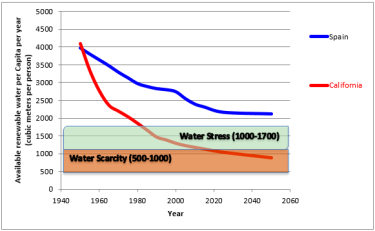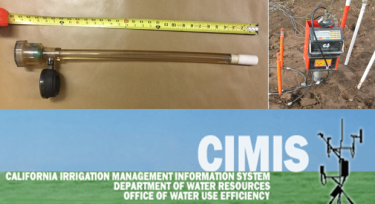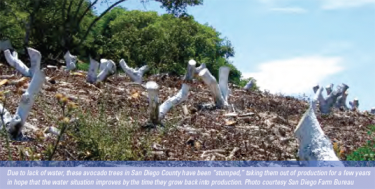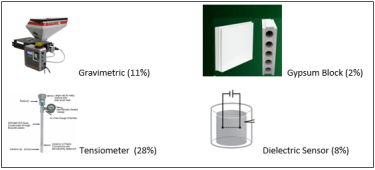

Notes: 1 acre-foot = 1,235 cubic meters.
Source: Calculated by authors based U.S. Central
Intelligence Agency (2015), U.S. Department of Commerce
(2016), Hanak et al. (2011), and California Department of
Finance (2016).
California, the leading agricultural producer state in the nation, faces recurrent droughts, including the severe 2009–2016 drought. After record-breaking amounts of rainfall (27.81 inches) (National Oceanic and Atmospheric Administration, 2017) and snow pack in water-tower reservoirs in the Sierra Nevada mountains (89.7 inches) in winter 2016–spring 2017, the National Weather Service (2017) officially declared the drought to be over. However, it would be reckless to think that droughts and water scarcity will disappear from California’s agenda. Using a very simplistic measure of water scarcity—the available water scarcity per capita per year over time (Figure 1), it is clear that California faces a much more water-scarce future, even without droughts or other climatic shocks. Comparing California to Spain, a country with similar climate, agriculture, and history of water management, one can see the significant gap that makes California prone to future droughts.
California’s agriculture has been affected by droughts to various degrees, depending on the region and the local farming sector’s ability to adapt (Medellín-Azuara and Lund, 2016). At the same time, farmers have adapted to drought situations in various ways. In this article, we discuss grower adaptation behavior under water scarcity and deteriorated quality in several distinct Southern California growing regions. Crop types include avocado in coastal counties (Reints, Dinar, and Crowley, 2017) and mixed crop farming under desert conditions (Ashraf 2017).
Previous work suggests that growers may respond to lower availability and quality of irrigation water (e.g., higher salinity level) using different short- and long-term water-management strategies. For instance, growers may modify their irrigation schedule by introducing new monitoring and scheduling techniques and equipment (Figure 2). They may fallow part of their land to adjust the irrigation area to the reduced amount of their available water. They may intensify their consultation for advice on irrigation and related matters with agricultural extension specialists and commercial agents. They may also invest in changes to the irrigation technologies/infrastructure they use. Farmers may switch crops or invest in alternative water sources such as drilling wells to pump groundwater and/or using treated wastewater. In the case of avocado, farmers may also elect a more drastic strategy by stumping the canopy of the trees in their grove (Figure 3) and keeping trees “afloat” (un-productive), surviving on a very small amount of water, until water conditions improve and production can be resumed.

Sources: Row 1 (left to right): Tensiometer, photo taken by
Julie Reints; neutron probe, University of Sydney
(http://ictinternational.com/products/smart503/neutron-
probe-smart503/).
Row 2: California Irrigation Management Information
System website page header (http://www.cimis.water.ca.
gov/Default.aspx).

Source: Gordon (2009).
We consider the bundle approach to growers’ adoption of technologies and management practices. Bundling, combining discrete technologies and management practices, occurs when growers use several technologies and management practices instead of adopting one technology or management practice. Using the bundle approach to maximizing scarce resources may provide growers more flexibility than adopting individual technologies or management practices. Such flexibility may help growers fare better under limiting climatic and water conditions, provide resiliency, and result in higher profits, as observed by Wang et al. (2010) and Fleischer, Mendelsohn, and Dinar (2011).
Avocado is commercially grown in six coastal counties of Central and Southern California: Orange, Riverside, Santa Barbara, San Luis Obispo, San Diego, and Ventura. Within these counties, avocado production covers nearly 57,000 acres and is managed by about 5,000 grower operations (California Avocado Commission, 2013). In these regions, avocado growers may face highly saline and/or chlorine water, interruptions to water delivery, mandatory reductions of water use, and rising water costs.
These areas of California have very different evapotranspiration zones, which suggests possible differences in adoption based on farm location. For instance, in Santa Barbara and San Luis Obispo Counties, where avocado is typically grown within 20 miles of the coast, rainfall and humidity are greater and mean annual temperature is lower compared to the most southern parts of the state—such as Riverside, San Diego, and Ventura counties—where avocado is also grown.
Avocado growers reported using several water-saving technologies and management practices, including (1) seven soil moisture measuring devices that allow growers to potentially produce the same level of yield with less water; (2) one irrigation calculator, designed to help growers determine site-specific crop water requirements based on weather data and crop coefficients; (3) five water-saving techniques that temporarily reduce water supply to and consumption by trees; (4) five water-management techniques that improve water-distribution uniformity and salinity control; (5) five irrigation technologies; and (6) miscellaneous techniques.
Four bundles of technologies and water-saving techniques, found to be significantly different from each other, represent the most common types of bundle management approaches (Reints et al., 2017):
We sought to identify determinants that explain selection of the various bundles among avocado growers in California through surveys of all commercial California avocado growers (5,135 growers farming 53,780 acres) in San Diego, Ventura, Riverside, San Luis Obispo, Santa Barbara, and Orange counties. Riverside and San Diego counties are the most arid avocado-growing regions; they are affected more severely by droughts and lack high-quality irrigation water. This analysis uses 123 avocado growers farming 3,899 acres.
We estimated adoption of water-saving practices using two methods: (1) the likelihood of grower adoption of any technology or water-saving practice, and (2) the likelihood of grower adoption of bundled technologies. For the first case we confirmed that, holding all other variables constant, farm location in arid counties has an effect on adoption. The probability of being an adopter of any irrigation management practice or technology increases when orchards are located in Riverside County, when owners have a higher income share from avocado production, and when they highly value information from cooperative extension. The probability of being an adopter decreases with the farm’s irrigation complexity and the owner’s age.
For the second case, estimating bundle adoption, the most significant factor in growers selecting bundle 1 were the grower’s income share from avocado production and informational factors such as use of cooperative extension advice. We did not find that farm characteristics, such as location, had an important contribution to selecting bundle 1. However, farm characteristics and location of orchard, were important for a grower to choose bundle 2. Age, education, and share of income from avocado also explained a grower’s decision to select bundle 2, as did use of cooperative extension.
The probability of a grower using Bundle 3 increases for farms located in San Diego or Riverside counties, the most arid regions of California. Owner’s age in all bundles decreased the probability of using bundles 2 and 3. This trend has been seen in previous literature (Fleischer, Mendelsohn, and Dinar, 2011; Wang et al., 2010). The probability of selecting bundle 3 was decreased by the farm’s irrigation complexity. Income share from avocado and use of cooperative extension were also important factors affecting a grower’s decision to select bundle 3 for irrigation management.
Desert and Southern California agricultural systems rely on supplies of irrigation water and therefore on water availability. In this analysis, we were interested in incorporating the diverse institutional arrangements, climate, land quality, and crop choices of farmers in agricultural counties in desert and Southern California into a single, meaningful analysis. Previous adoption studies in California have focused on the Central Valley, which tends to have more homogeneous growing conditions relative to Southern California (Osgood, 1999; Green et al., 1996). Additionally, we were interested in the extent to which adopting technologies that promote irrigation efficiency (using the definition in Burt et al., 1997) represents adaptation to an increasingly warm and dry climate.

This analysis focused on measuring farmer adaptation of moisture-monitoring techniques (Figure 4) and water quality (salinity) monitoring devices in four desert and Southern California counties through a survey of 1,268 potential agricultural operator respondents in Imperial, Riverside, San Diego, and Ventura counties. A total of 221 responses, 195 of which were valid, were used in the analysis. Farmer response to water scarcity and deteriorated water quality was a result of various type of information and know how sources. Their choice of management practices was guided by the impact of their perceptions of water scarcity; in extreme cases, they responded by selling their land and moving out of agriculture.
We categorized farmers’ perceptions regarding the primary threats to future water supplies as follows: drought, environmental groups opposition, tighter government regulations, population growth in urban centers, and no threats. We found that perceptions about population growth and government regulations increased the likelihood of adopting soil management practices relative to perception of drought. But, perceptions regarding environmental groups opposition impacts may not increase adoption likelihood relative to perception of drought impact.
Findings suggest that farm type (crop mix) plays a role in the decision to adopt soil moisture-monitoring technologies. Several farm types categorize desert and Southern California agriculture: grain/field crop farms, mixed crop farms (without a single majority type of crop), vegetable farms, orchard farms, and vineyard farms. Vineyard, mixed crop, and orchard farms have almost six-, five-, and four-fold increases in the likelihood of adopting soil moisture-monitoring technologies relative to field crop farms. It may be interesting for policy-makers to note that growers who diversify their crop categories (i.e., mixed farms) may also be more likely to adapt by adopting soil moisture-monitoring techniques relative to the baseline farm type (field crops).
In reaching their adaptation decisions farmers indicated using information provided by the following sources: government/university Extension, industry, professional farm managers, friends/neighbors farmers, and popular press. The most relevant finding for policy is that the likelihood of adopting soil moisture-monitoring technologies more than doubled when a grower received information from government or university extension rather than relying on neighboring farmers. This result suggests an important role for information provided by Cooperative Extension.
Another important result relates to the salinity-monitoring variable, the analogous variable for soil moisture monitoring, which represents the use of at least one salinity-monitoring device. We find that the likelihood of adopting a soil moisture-monitoring technology increases by almost by 600% when the grower has also adopted salinity-monitoring devices. Hence, adoption in bundles provides stronger incentives for adoption. This is also an important finding for policy-makers with respect to the target population, as it suggests that those who adopt one practice may be more likely to adopt another. It may be more cost-effective to direct outreach efforts to those growers who have already adopted water management or water quality practices.
We also found a farm size effect in the adoption of soil moisture-monitoring technologies, suggesting that larger farms are more likely to adopt soil moisture-monitoring technologies. This is also an important finding for policy because it suggests the need for different policies to target different farm sizes.
As a final note, we highlight the large magnitude of the intra-annual climatic variability measures (temperature and precipitation) relative to mean conditions, which may be dampening the effect of climate extremes experienced throughout the year. This may suggest that farms experiencing climatic extremes across seasons in a given year—and who therefore experience more uncertainty—may be more likely to offset some of this uncertainty by adopting more monitoring practices.
Our analysis implies that information providers such as University of California (UC) Cooperative Extension play an important role in adopting water-saving and water-quality-monitoring technologies and management practices for California avocado growers and for desert and Southern California farmers. Cooperative Extension advisors and specialists are able to distribute research findings and tools necessary for growers to mitigate the impact of drought and deteriorated water quality. Access to information and knowledge provided by public agencies, such that UC Cooperative Extension, would increase the likelihood of technology adoption among farmers.
It was also found that human capital variables such as age and education are important in grower decision-making concerning water management. The importance of the share of farm income from avocado production was significant for grower bundle adoption, implying that grower specialization positively impacts decisions about water management on the primary crop.
In addition, this research demonstrates that growers will need to be flexible in their approach to water management to mitigate climate change and reductions in irrigation water quantity and quality. Growers who were able to select from many different discrete management tools to manage water were located in Riverside and San Diego counties and had less complex irrigation systems. Riverside and San Diego Counties have higher aridity indexes and are predominantly on district water, typically a more expensive option for growers. Growers may benefit from redesigning and simplifying their irrigations systems in order to keep them maintained and water-efficient in areas where less water is available.
There are several policy implications arising from these analyses. First, we found that a combination of variables motivate farmer adoption, starting with making information available through Cooperative Extension services. County-specific services—such as Extension, laboratory testing, etc.—play an important role in enabling farmers to adopt technologies and bundles. Policies that enhance these services could make a difference in farmers’ success when they face water scarcity and deteriorated quality.
Second, we realize that regional differences exist (e.g., soil, climate, access to markets, services) and, thus, policy responses can account for these regional differences and provide a quilt rather than an umbrella policy. Regions with big urban centers could also take advantage of an additional source of water in the form of treated wastewater, which may benefit farmers if properly treated and adequately priced.
Finally, we also realize that farm size is an important factor in the ability of farms to adapt their water management practices and technologies in response to water scarcity. Policies that differentiate between farms of different sizes would be more effective.
Ashraf, A. 2017. “Assessing the Resilience of Desert and Southern California Farming Systems to Water Scarcity.” PhD Dissertation, University of California, Riverside.
Burt, C.M, A.J. Clemmens, T.S. Strelkoff, K.H. Solomon, R.D. Bliesner, L.A. Hardy,T.A. Howell, and D.E. Eisenhauer. 1997. “Irrigation Performance Measures: Efficiency and Uniformity.” Journal of Irrigation and Drainage Engineering 123:423–42.
California Avocado Commission, 2013. “Acreage Inventory Summaries.” Available online: http://www.californiaavocadogrowers.com/industry/acreage-inventory-summaries
California Department of Finance. 2016. “Summary Population Projections by Race/Ethnicity and by Major Age Groups.” Sacramento, CA: Report P-1. Available online: http://www.dof.ca.gov/Forecasting/Demographics/projections/
Fleischer, A., R. Mendelsohn, and A. Dinar. 2011. “Bundling Agricultural Technologies to Adapt to Climate Change.” Technological Forecasting and Social Change 78:982–990.
Green G., D. Sunding, D. Zilberman, and D. Parker, 1996. “Explaining Irrigation Technology Choices: A Microparameter Approach.” American Journal of Agricultural Economics 78: 1064–1072.
Gordon, D. 2009. “Commentary: California’s 30-Year Drought.” Rural Cooperatives May/June:2. Available online: https://www.rd.usda.gov/files/CoopMag-may09.pdf.
Hanak, E., J. Lund, A. Dinar, B. Gray, R. Howitt, J. Mount, P. Moyle, and B. Thompson. 2011. Managing California's Water: From Conflict to Reconciliation. San Francisco: Public Policy Institute of California. Available online: http://www.ppic.org/content/pubs/report/R_211EHR.pdf
Medellín-Azuara, J., and J.R. Lund Jr. 2016. “Economic Impacts of Recent California Droughts.” University of California Center for Watershed Sciences.
Mendelsohn, R., and A. Dinar. 2003. “Climate, Water, and Agriculture.” Land Economics 79(3):328–341.
Mendelsohn, R., W. Nordhaus, and D. Shaw. 1994. “The Impact of Global Warming on Agriculture: A Ricardian Analysis.” American Economic Review 84(4):753–771.
National Weather Service. 2017. NWS Forecast Office Sacramento, CA. Available online: http://www.weather.gov/sto/
National Oceanic and Atmospheric Administration. 2017. “Weather and Climate 2017.” , Asheville, NC: National Centers for Environmental Information. Available online: https://www.ncdc.noaa.gov/
Osgood, D. 1999. “Information, Precision, and Waste.” Doctoral Dissertation in Agricultural and Resource Economics. University of California, Berkeley.
Reints, J., A. Dinar, and D. Crowley. 2017. “Dealing with Water Scarcity: Adoption of Water Saving Technologies and Management Practices by California Avocado Growers.” University of California, Riverside, School of Public Policy Working Paper 17-02, May. Available online: http://spp.ucr.edu/publications/dealing-with-water-scarcity.pdf
U.S. Department of Commerce. 2016. International Programs. International Data Base: World Population 1950–2050. U.S. Census Bureau. Available online: https://www.census.gov/population/international/data/idb/worldpopgraph.php
U.S. Central Intelligence Agency. 2015. World Factbook 2015. Available online: https://www.cia.gov/library/publications/the-world-factbook/
Wang, J., R. Mendelsohn, A. Dinar, and J. Huang. 2010. “How Chinese Farmers Change Crop Choice to Adapt to Climate Change.” Climate Change Economics 1(3):167–185.